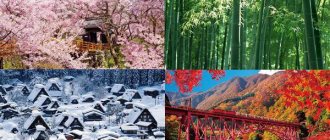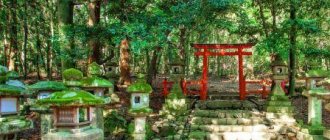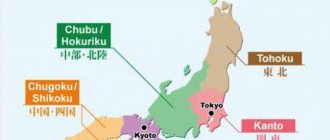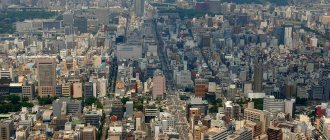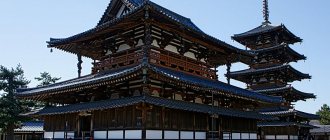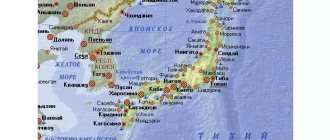The Japanese archipelago consists of hundreds of islands stretching from north to south. Such geography provides the country with climatic diversity, so there is no single concept of the Japanese climate. The climate in Japan varies significantly depending on the region. In January, when there is frost and snow in the north, sakura blooms in the southern regions, and the average temperature does not fall below 10-15 degrees Celsius.
A land of contrasts: frosts and subtropics
The climatic zones of Japan are strikingly diverse: almost all types of climate are represented here. The four main islands stretch from north to south for 3 thousand km: Hokkaido, Honshu, Kyushu, Shikoku. The northern part of Hokkaido is located in the subarctic zone, and the south of the country is already in the subtropics.
Since the country is surrounded on all sides by the ocean, the weather has its own characteristics. In winter, wet monsoons constantly blow from the Eurasian continent, bringing rain and snow to the western part of the archipelago. During this time, the eastern Pacific coast is mostly clear and dry.
Spring begins with strong winds blowing in February-March. These are the first signs of the spring season.
Climatic conditions on the largest islands - Honshu, Shikoku and Kyushu - are milder than in the north. Winters are warm, temperatures do not drop below zero, although there are heavy snowfalls. At the beginning of summer, monsoon rains begin, humidity reaches 100%.
From mid-summer to early autumn, temperatures reach +30 Celsius and above, attracting vacationers to the beaches. At the end of September the heat subsides and the number of tourists increases.
Typhoons, which appear from June to October, causing destruction and danger to people's lives, are considered a real disaster for the climate of the islands.
Winter in Japan
The winter months are especially different from region to region. So, in Hokkaido, especially in the northern part of the island, there is a fairly severe snowy winter, and the temperature can drop to 15-20 degrees below zero.
It is quite warm in Honshu and Shikoku in December-January: +5…+7 degrees. The Ryukyu Islands and Okinawa are located in southern latitudes; a monsoon climate prevails here and the temperature rarely drops below 10-12 degrees Celsius.
The Pacific coast has a mild climate: with the onset of winter, the air temperature here drops, but it rarely drops below zero. At the same time, in Northern Japan, snow falls from the first days of December, which lies there throughout the winter; in the center of the country, precipitation is extremely rare, and in the south there is no snow at all.
When you come to Japan in winter, you can first go skiing in Sapporo, and then go to Okinawa and scuba dive.
The weather in Japan by winter months in the main cities of the country looks like this:
| December | January | February | |
| Tokyo | +8…+11 | +6…+9 | +8…+10 |
| Kyoto | +9…+11 | +5…+7 | +9…+11 |
| Osaka | +8…+10 | +5…+7 | +6…+8 |
| Nara | +5…+8 | +3…+6 | +4…+7 |
| Sapporo | -1… -2 | -2… -3 | -1… +1 |
Features of transitional climate zones
Subequatorial
They surround the equatorial zone from the north and south. Here, equatorial air masses predominate in summer, and tropical ones in winter). There is a clear division into two periods - summer with a lot of rain and winter with droughts. The temperature all year round is quite favorable - from +20 to +30 °C, precipitation - up to 2000 mm per year.
Subtropical
Tropical air masses affect them in the summer, and moderate air masses affect them in the winter.
- In the continental west, conditions are also called Mediterranean (dry and hot in summer up to +30 °C, in winter - wet and warm up to +10 °C with very rare frosts).
- In the continental east, the conditions are different - monsoonal (in summer up to +28 °C, a lot of rain, and in winter - dry, up to +28 °C, rain per year - up to 1500 mm, but snow is very rare).
- The continental centers are characterized by a continental subtropical climate (in summer - dry and hot up to +30 °C, in winter also dry but cool - up to +8 °C).
Subtropics
Subpolar (subarctic and subantarctic)
They are located north and south of temperate climate zones. In summer there are more moderate air currents, in winter - Arctic and Antarctic.
- The northern continental ends are characterized by a continental subarctic climate (in summer up to +10 °C, but this is a very short period, but in winter - up to -50 °C, in some places even up to -75 °C).
- You've probably heard about permafrost - this phenomenon can be seen right here, since at extremely low temperatures, large expanses were swamped with very high moisture, although there was little precipitation - up to 200 mm per year.
Very coldy
It is much more favorable in the oceanic climate (Greenland and Norwegian seas, the area near Antarctica) - with an abundance of cyclones, summer with temperatures up to +5 °C and winter with temperatures up to -15 °C. It is here that you can see floating sea ice, and fog is also characteristic of these places. In winter, up to 500 mm of precipitation falls.
Spring in Japan
The Japanese are careful about their weather, as it often brings them a lot of problems. So, everyone is looking forward to strong winds in February-March - they are the ones, according to old beliefs, that bring spring.
In general, spring in Japan is warm and sunny. Throughout the entire territory, except for the northern regions, already in March the temperature reaches +10, and in April on the large islands the air is filled with the fragrance of flowering apricot trees and the legendary sakura. This period is called Hanami.
Thanks to the huge extent of the country from north to south, you can watch the blossoming of these amazingly beautiful trees for several months: on the islands of Okinawa and Kyushu, sakura blooms at the end of February, in Tokyo and Kyoto it begins to bloom at the end of March, and in Hokkaido - at the end April - early May.
Thus, the whole spring in Japan passes under the sign of “Time of admiring flowers.” If you're deciding when to go to Japan, it's hard to find a better time. At the end of May the air warms up to + 25…+ 30 degrees.
In spring, temperature indicators for the main cities of the country look like this.
| March | April | May | |
| Tokyo | +9…+11 | +15…+18 | +18…+21 |
| Kyoto | +10…+12 | +15…+18 | +20…+23 |
| Osaka | +9…+12 | +14…+17 | +18…+22 |
| Nara | +7…+11 | +12…+16 | +17…+22 |
| Sapporo | +1…+3 | +7…+10 | +11…+14 |
How to get there
A common method is by air. In a small country, 173 airports accept aircraft.
Popular flights to Japan:
- Japan Airlines, Japan's flag carrier, departs from Domodedovo, Moscow, to Narita Airport, Tokyo, three times a week;
- Aeroflot planes fly daily from Sheremetyevo, Moscow, to Tokyo;
- from Khabarovsk, Vladivostok, Yuzhno-Sakhalinsk Aeroflot planes deliver tourists to the capital of Japan 1-2 times a week;
- You can get from Vladivostok and Khabarovsk to Tokyo by air;
- Sakhalin Airways airbuses run from Yuzhno-Sakhalinsk to Sapporo twice a week;
- Vladivostok Air operates flights from Vladivostok to Tokyo.
With transfers in Munich, Frankfurt am Main, Helsinki, Seoul, you can get to Japan thanks to the airliners Lufthansa, Finnair, KLM, Korean Air.
The easiest way to get to the Japanese islands is for residents of Sakhalin. High-speed ferry crossings from the port of Korsakov to Hokkaido take only 4 hours and cost less than a flight.
Summer in Japan
The summer period begins exactly on schedule: at the beginning of June. It is from the first month of summer that the heat begins, but the rainy season in Japan also begins in June. It rains frequently, heavily, and can last for weeks.
The Japanese don't really like their summer: these are the months when deadly typhoons strike. Humidity increases to 100%, and the heat is set at +28...+30 degrees and above.
July is characterized by a decrease in the amount of rain, humidity also decreases - up to 90%.
July and August are the best time for a beach holiday: only on the coast do the Japanese and guests of the Land of the Rising Sun escape the tropical heat and humidity. There are many holidays and excursions held in the resort towns of Japan. Going on an ocean cruise on a boat, you can watch whales.
The average temperature in summer is as follows:
| June | July | August | |
| Tokyo | +20…+25 | +26…+30 | +28…+30 |
| Kyoto | +26…+27 | +29…+31 | +30…+32 |
| Osaka | +22…+25 | +26…+29 | +27…+30 |
| Nara | +20…+24 | +25…+28 | +25…+29 |
| Sapporo | +16…+20 | +21…+25 | +23…+27 |
Frosts come suddenly or three wintering problems for “gaijin”
I experienced the first shock from Japan when I arrived there again in the summer. It seemed that now I had gone straight to hell in a frying pan. Despite the fact that I was used to the heat, I experienced a climatic knockdown. The situation was aggravated by almost one hundred percent humidity - a phenomenon that I had previously experienced in some countries was repeated. But I’ll talk about summer another time.
So, the hot summer is over, and the temperature dropped a little every day. Then new phenomena, little known to me, began, such as typhoons and seasonal rains. But they also ended and the time of quiet and sad autumn began, when I felt good again. For the “Homeland of the Sun” this is a time of wonderful colors and beautiful landscapes.
Then autumn gradually fades away, giving way to the Japanese winter - a time of severe trials for a foreigner just starting to live here. Then I didn’t yet know what was insidious about the seemingly “mild” winter in Japan and whether it even existed in the usual sense for us.
I can’t resist posting below an old photo from 2013, taken on a rather snowy January day. I really like bright, elegant kimonos combined with fur collars.
This day fell on a popular Japanese holiday - Coming of Age Day. About every year since the end of the forties in mid-January, or rather on its 2nd Monday.
The girls in the photo have already become adults - they are 20 years old. According to tradition, this holiday is celebrated in traditional national clothes.
Regarding the frost, the title above is of course overkill. But the fact is that the “descendants of the samurai” endure the local winter much easier than summer. Children are hardened a lot, and local schoolgirls wear short skirts with open legs all winter. The warmest thing that can be worn over the uniform is a warm scarf. Weather and upbringing do their job.
In fact, it is impossible to definitively answer the question of what the average temperature in Japan is in winter. Still, this is a country, although it is not huge in territory, but it is climatically diverse.
If we talk about the central part of the country, including Tokyo, then it certainly gets below minus in winter, and the average temperature fluctuates around -4.5C°. Snowfalls are quite rare, and the snow that does fall melts quickly.
After all, most likely you will live in a hotel, and any public place here is perfectly heated, or you will live with Japanese friends who will insulate your room in the best possible way. As the popular joke goes: “There is a big difference between a tourist trip and permanent residence”
And now about the real problems that await the gaijin in the Land of the Rising Sun:
- The first problem, which is also the main one, is that in winter in Japan (except for the frosty northern regions, and this is a separate issue) there is no central heating, and the temperature in the house becomes almost the same as outside. And everyone heats their home as best they can;
- The second problem is that Japan has virtually no natural resources or minerals. Natural gas is imported and expensive. Electricity is also very expensive. Therefore, long-term use of heaters takes a toll on your pocket.
- The third problem is the design of Japanese houses themselves. It is rather more thought out for the stuffy summer and, in addition, for frequent earthquakes. And if you are a foreigner, then it is better to live in a house with stone walls than with thin wooden ones.
In houses with stone walls, arms and legs do not begin to stiffen so quickly. I saw residents of the northern regions - Canadians and our Siberians, wintering for the first time in Japan with faces gray from the constant cold.
I had a similar situation with my house. The house I stayed in was an old two-story building with thin walls and sliding windows, which I didn’t even try to cover because of the complexity of the procedure.
Millions of Japanese live in houses like mine. Such a house may withstand earthquakes and heavy rains, but in the cold it did not try to adequately protect it.
Despite the fact that I have always been well-hardened, with the first cold weather I began to experience severe discomfort, especially in the evening, at night and in the morning. It was good only during the day, within the warm walls of the company.
Autumn in Japan
The first signs of the onset of autumn can be observed in late August - early September, when the air temperature gradually begins to decrease, remaining on average at a comfortable 25 degrees in most regions of the country. And although on some days in September the temperature sometimes reaches +28...+30 degrees, in October on some days the temperature in the capital no longer exceeds +13...+15 degrees.
Humidity drops in autumn, the picture of nature withering is pleasing to the eye, while the weather is mild and warm. Chrysanthemums are blooming, maple leaves are blazing with fire. Many travelers choose autumn for their trip, when the country looks especially attractive.
Autumn temperature indicators:
| September | October | November | |
| Tokyo | +25…+28 | +20…+23 | +15…+18 |
| Kyoto | +26…+29 | +20…+23 | +16…+18 |
| Osaka | +23…+26 | +18…+21 | +13…+15 |
| Nara | +21…+25 | +16…+20 | +11…+14 |
| Sapporo | +19…+22 | +12…+15 | +6…+8 |
When is the best time to visit Japan?
When choosing a time to travel to Japan, it is best to look at the map where exactly you are going.
The most popular excursions in Japan are during cherry blossoms - in spring. You can come to Okinawa at the end of February to admire this spectacle, when there is still snow on the main territory of Russia.
The beginning of summer is a rainy period, unfavorable for tourism. In July–August there is less rain, but it becomes too hot and stuffy.
Those who are interested in surfing come in the summer to the resort of Kamakura, the Ryukyu Islands, and Okinawa. Coral reef lovers gather on Keramo Island.
The best time to holiday in Japan, according to many, is mid-autumn. In October, festivals of music, dance, and traditional Japanese arts are held.
One of the most spectacular festivals, the Jidai Matsuri, is held in Kyoto every year on October 22. This is a festive costume procession, a historical reconstruction of the imperial procession, attracting numerous tourists.
Japan looks very beautiful on the eve of the Christmas and New Year holidays. The north of the country is covered with snow, but the weather is quite warm.
There are three popular ski areas in Hokkaido - Niseko, Furano and Rusutsu - with developed infrastructure and slopes for skiers of all levels.
Lovers of winter swimming in thermal springs near Mount Fuji also come to Japan.

